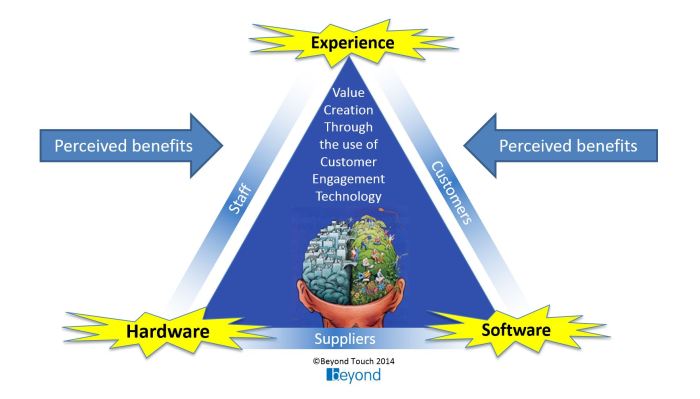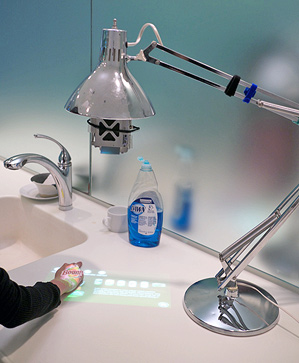Ringly that connects to your phone and vibrates and lights up @getringly #BYOW #WearWare http://ow.ly/HM6JU
If you find this article to be of interest why not check out our latest work:
Ringly that connects to your phone and vibrates and lights up @getringly #BYOW #WearWare http://ow.ly/HM6JU
If you find this article to be of interest why not check out our latest work:

The customer whom is engaged in the retail experience is charmed by the story unfolding, enraptured by the spectacle and ultimately persuaded to make in store purchases by well-placed cues, triggers and props. Retailers use a variety of technological levers to assist them in this pursuit – to get the customer touching, listening, looking and learning for themselves about the products in store. But many companies fail to choose the best tools for getting the job done right first time. Graeme Laws puts forward the case that technology alone is not a panacea for success but is part of an ongoing journey of experimentation. It requires co-creation, with the customer fully participating, in order to deliver sustainable commercial benefits.
The idea of CET [Customer Engagement Technology] is to provide a useful interface for shoppers to get what they want and in doing so have a good time – right? Usually this is achieved through the use of a customer’s eyes, fingertips, gestures or voice. Think video walls, self-serve kiosks, tablets, digital signage, holograms, projections, gesture controlled retail gamification, RFID identification, QR code/NFC couponing etc… In my pursuit of the ultimate shopping experience through CET, I have travelled the world, seeing the wild and the downright stupid put into practice.
I have become fascinated with observing shoppers as they try to go about their business often hindered by CET. I am not suggesting that I lurk in the aisles like a shifty shoplifter – though this is a sure-fire way of testing the standard of CCTV technology in branch – more so I take every opportunity to observe the conjunction of people and technology as I do my own shopping. I’m kind of like a secret shopper without a company credit card to support my clandestine observational missions – incidentally I am available for hire should your company wish to employ the services of a CET analyst. Just let me loose on your market with a credit card and a digital notepad and see what I come back with…
Sometimes I will observe a great piece of retail theatre – a sheer delight to watch and to participate in. There are other times when the ‘experience’ so utterly fails to engage the customer that one feels like praying for peak oil and the subsequent global black-out to hurry up and stop this terrible retail technology nexus in its tracks. If it is not poorly planned click and collect services, or sub-standard digital signage, it is armies of in-store assistants brandishing iPads like weapons of mass engagement. As a busy shopper I find BYOD in store acts like garlic on them…
In spite of the aforementioned diatribe I should go on record as saying that I am a fan-boy of all forms of CET. I go looking for the stuff – my friends and family report back with something new they have seen. Its like trainspotting but with LEDs and sensors replacing the smoke and whistles – I make notes whilst out and about on a day off. Why? Because CET matters – what happens in store is a reflection of the whole industry – you make one another look great/bad. In CET terms ‘good’ should be aesthetically designed, offering a compelling reason to be used and ought to deliver a satisfactory customer experience. If it does not tick all of these boxes then it should be trialled and shelved – excuse the pun – with a label on the box saying ‘not good’.
And right here is my own dichotomy – on the one hand I cannot abide a lousy customer experience using an ill-conceived notion of technological connectivity. Yet as a futurist in tech innovation I feel I should embrace rapid prototyping, live beta trials and the occasional subsequent failure. The good news is I do willingly accept my role as a CET guinea pig. My only proviso is that should the CET project fail to deliver, it should do so fast and moves forward with a hefty lessons learned log into the next phase. ‘Test fast, fail fast & adjust fast’ – Tom Peters.
For many companies that have invested heavily, CET projects are treated like an all or nothing commercial strategy. Like a digital end game – I can see the red, ‘go nuclear’ button flashing on their blessed corporate iPads as I write this. ‘Gotta light the whole goddam store up with enough LED to give everyone a tan’. Their mistake is that there is often nothing in the plan for it to evolve. It’s as if their plan was designed, like a fly trapped in amber, for those screens and GUI’s to be preserved for eternity in their locale, never degrading, never transforming and, worst of all never being used. Yet consumerism is a by-product of capitalism and moves quickly and absolutely. Consumerism is also but one element of the retail consciousness, experiencing itself subjectively through campaigns and promotions. Its very nature is transient – a temporary material construct and should be able to transmogrify in perpetuity as a reflection of the zeitgeist. Sadly not all companies have a budget for that – it was all used up on a 6 metre x 12 metre touch enabled video wall that requires a step ladder to make best use of. That was one real example of where Cap-Ex flew out of the door as CET came in the window.
The reality is customers – people like you and I – vote with our senses when confronted by new things. Sure we will try them out but ultimately we are governed by our own attitudes toward them. This perception is based on usefulness of the CET and the ease of its use. If it looks hard and/or doesn’t deliver on the promise – of speed, quality, variety, fun – we vote with our feet and leg it. Too many businesses focus only on what it looks like as opposed to what it actually delivers. The bitterness of poor CET lingers longer after the sweetness of the products in store have been forgotten. A good CET strategy should carry the experience out of the store and into the customer’s social sphere. By virtue of the experience being evangelised by the user they take your brand into an intimate realm of personal endorsement and recommendation – the holy grail of marketing no less. We like to talk about good experiences, but we also like a good whinge! You have to get it right – or run the risk of your reputation being less than one step ahead of its own disastrous PR debris!
I would highly recommend any company embarking on a CET project to remember the three golden rules of engagement strategy:
Bleeding Edge Technology – When Tinkering Goes Bad. By virtue of its proximity to the tech event horizon, consumer driven, innovative gadgets are prone to being stretched beyond reasonable and practicable use. Graeme Laws will pose searching questions; Are you prepared to dabble in the grey world of Beta Engagement Technologies? From Google Glass to MYO armbands via transparent touch screens and indoor ‘delivery’ quad copters– there are plenty of toys to play with but how ‘Enterprise’ are they? Do we really want to take it from the lab or livingroom straight into the workplace?
There’s a new wave of interactivity heading to store shelves — one in which there’s no touchscreen required.
A new kind of retail digital signage projection technology from MIT graduates in New York aims to take the best of tablet and touchscreen digital signage and update the in-store shopping experience — with an interactive display on a typical wooden table.
This is a link to a great article on innovation within retail. It has access to lots of cool data and video content.
A great article by Russell Willcox on technological innovation in retailing. @BoxTechnologies
Showrooming – the practice of using a high street store’s goods and services to try out a product before going online to buy it at the lowest price possible, is not a new shopping trend. Online portal Statista.com reports that ’48% of showroomers use physical stores to research products with no intention of making a purchase’.
http://www.boxtechnologies.com/blog/showrooming-is-taking-on-a-new-life/
The whole concept of diminished reality is like some 21st century reductionist version of 5S. Blanking things out from your technological second eye. It is an inversion of augmented reality and I find the possibilities for this fascinating. What if we could block out unsolicited advertising? Or speed up Post-production clean up of film making.
The future of the desktop will see gestures and inert surfaces morph into a hybrid touch solution. We can expect to see software becoming the disruptive piece of technology in the touchscreen domain.

http://mashable.com/2011/11/21/exodesk/?WT.mc_id=obinsite

Powerful computers are becoming small and cheap enough to cram into all sorts of everyday objects. Natan Linder, a student at MIT’s Media Lab, thinks that fitting one inside a light bulb socket, together with a camera and projector, could provide a revolutionary new kind of interface—by turning any table or desk into a simple touch screen.

Read more about this here